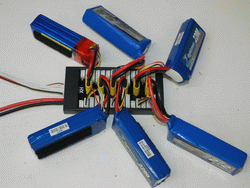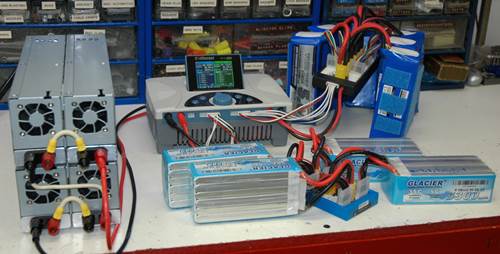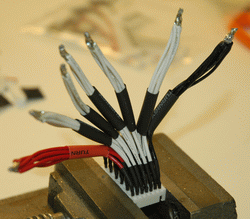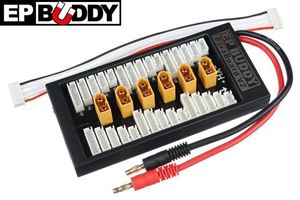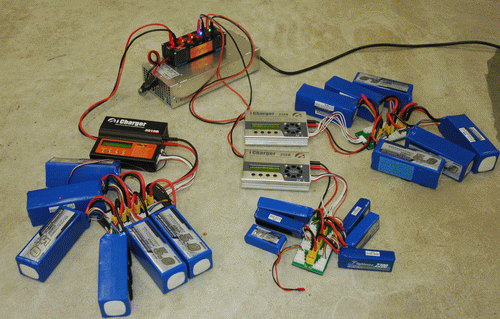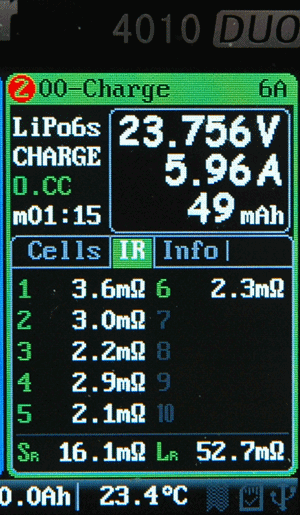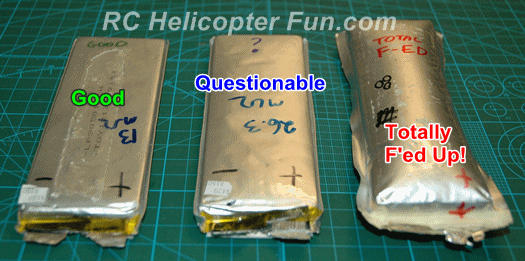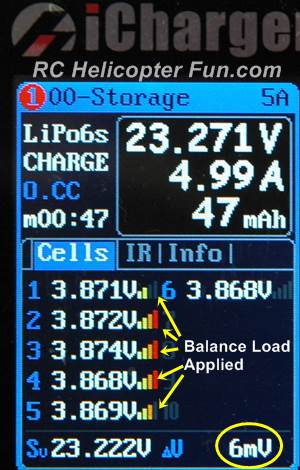What Is Parallel LiPo Charging, How It's Done & Is It Safe?
by John Salt - Updated November 2024
Parallel LiPo charging is very popular, but it can also be very dangerous if you don't understand a few things. Time to dispel the myths and fears so you can decide if it's a charging method you may want to use (now or later).
We will also examine why getting a higher power RC Battery Charger and RC Power Supply might be a good idea in the long haul even if you are only using smaller capacity LiPo Battery packs right now.
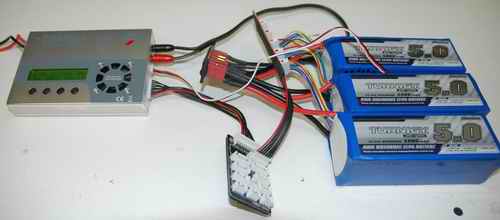 My First Successful Attempt At Para Charging Many Years Ago Now
My First Successful Attempt At Para Charging Many Years Ago NowParallel LiPo charging allows you to charge more than one battery at a time with your computerized RC battery charger.
I think you can already appreciate the advantage parallel LiPo charging offers us - it saves lots of time! Instead of charging each battery pack one at a time, para charging allows you to charge your entire heard of LiPo batts on one charge cycle at the same time.
Now, this is very important... Charging LiPo batteries in parallel will only work on SAME CELL COUNT batteries.
They can have different capacities (within reason). I follow no more than about a 20% capacity difference for healthy packs (i.e. a 5000mAh pack with a 4000 mah pack). There are exceptions to this (i.e charging at lower current rates), but to keep things simple and consistent, I stick with 20%.
The packs can also be at different states of charge - again within reason. You wouldn't want to try and parallel charge a pack that was 5% discharged with one that was 80% discharged for example.
The general rule I follow is no more than a 0.1 volt maximum difference between cells of packs I hook together in parallel.
This for example would be very close to the voltage difference between a cell that is 80% discharged (around 3.75V) and a cell that is in a 50% storage state (about 3.85V). The larger the voltage difference between packs hooked together in parallel, the larger the amount of current that flows between packs as they all equalize.
Below is a LiPo battery current flow video I made that demonstrates this in more detail.
Once again... The important thing to remember is the battery packs all have to be the same cell count. You can’t parallel charge a 6S LiPo pack with a 4S LiPo pack for example.
Words Of Caution!
Parallel LiPo charging is an advanced method of charging and requires a certain level of electrical understanding.
If you are not comfortable with charging calculations or your ability to safely build/use parallel charging harnesses or boards while keeping your wits about you when hooking up the batteries in parallel, please don’t attempt it.
As was discussed on the LiPo battery page, lithium battery chemistry is a volatile mixture. One battery starting on fire because of unsafe/improper charging is bad enough, never mind several batteries all hooked up in close proximity to each other!
If you choose to charge this way, just like charging any lithium based battery, you do so at your own risk and never unattended.
I also highly recommend monitoring and testing the voltages of your packs/cells the first time you try this to ensure everything is working correctly and one or more packs/cells is/are not getting overcharged for some reason.
Even after you know what you are doing, it never hurts to check the packs finished voltage at every charge cycle if you want to play things safe. I randomly take a few packs every several charge cycles to check the individual cell voltages to ensure they are all the same and none are over my fully charged termination voltage.
As you may have seen in above video, I use "ParaBoards" while "Para Charging".
They make for a neat, safe, hassle free hookup and they are pretty much "goof proof".
Highly recommended if you parallel charge and don't want to build your own harness &/or boards which I cover a little later on this page.
How Safe Is Parallel LiPo Charging?
As with any type of LiPo battery charging, parallel charging can be as safe or dangerous as you make it. As I just mentioned, this is an advanced method of charging and requires some basic DC circuit and Ohm's law understanding.
I have also read and even heard a fair amount of "fear mongering" out there about parallel LiPo charging damaging batteries.
Out of the half dozen LiPo experts I've talked to, and the numerous electrical engineers in the hobby I've also conversed with over the past decade; I simply can't find a single person in the know that will say parallel charging of LiPo batteries is more harmful than single pack charging or will reduce the pack's life span by over or undercharging some of the cells.
Provided you have good equipment, healthy batteries, and understand exactly what you are doing.
Perhaps some of these fears and misconceptions were brought about by people who figured they could cut corners and just hook the main power plugs up in parallel and not worry about the balance plugs? That of course will certainly lead to individual cells in the various packs getting over and under charged.
 You MUST connect each cell in the packs in parallel through the balance plugs for the voltages to be the same between cells!
You MUST connect each cell in the packs in parallel through the balance plugs for the voltages to be the same between cells!I've been para-charging LiPo packs now for over 14 years and have never once had any issues. My packs are living long healthy lives and I would guess I have had at least 1400 para-charging cycles presuming around 100 per year give or take.
Am I just lucky? Well, I would like to think there is more to this procedure than just luck. I will trust the electrical physics in other words over the anecdotal hearsay. Science wins out every time :-)
Of course, if you don't think parallel LiPo charging is a safe charging method, or you are not comfortable with it - don't do it!
This article is not meant to force anyone either way; it's just meant to explain what para-charging is, how it works, and the pros & cons. Hopefully giving those who want to try it a solid understanding based on facts - not fiction.
How Does Para Charging Work?
If you understand how Ohm's law works in relation to DC parallel circuits, you know the basic principle behind parallel charging, how it works, and why it's just as healthy for the LiPo as single pack charging - perhaps even healthier.
I have experienced this almost every time I parallel charge... The voltages of the individual cell branch circuits are almost always in closer balance proximity while balance charging, so the charger doesn't have to work as hard putting a resistive load on a certain branch to bring it/them down to balance with the rest of the cells/branches in the pack.
Why... Law of averages.
The more packs you have hooked up in parallel, the more evened out the internal resistance values will be between each branch of cells since it is very unlikely cell # 3 in all your packs has a slightly higher internal resistance than cell # 2.
The more common reality is every cell in every pack will have a marginally different internal resistances. This tends to even the resistance out on each cell branch very nicely resulting in the current flowing between branches being very even as well while the packs are charging. This also means your charger generally won't have to work as hard putting a balancing load on the individual branches to maintain a low mV delta between cells.
Again, just simple DC parallel circuit Ohm's law that we all learned back in high school physics - assuming you weren't skipping class that day ;-)
If you were, the video below will show what you missed.
What You Need To Para Charge LiPo Batteries
First you will need to build or purchase a parallel charge harness or board that the charge leads from each battery will be plugged into.
The positive from each plug is hooked to positive and the negative of each plug is hooked to negative (parallel circuit). To keep things in reason, most will only build or purchase a harness or board that will support up to 5 or 6 batts maximum.
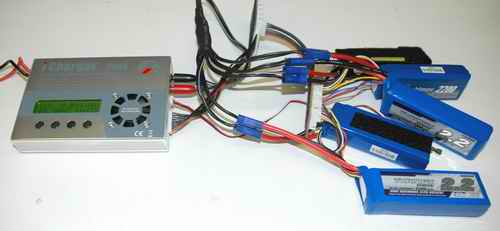
Things start to become a little congested as you can see with that amount of wiring and batteries, especially if you still want to use a fire safe charge container or bag while charging.
How To Build A Simple Parallel LiPo Charging Board or Harness
I built this para-board many years ago that supports all my LiPo packs that have Deans connectors. As you can see on the back side of the board, all the plugs are wired and soldered in parallel.
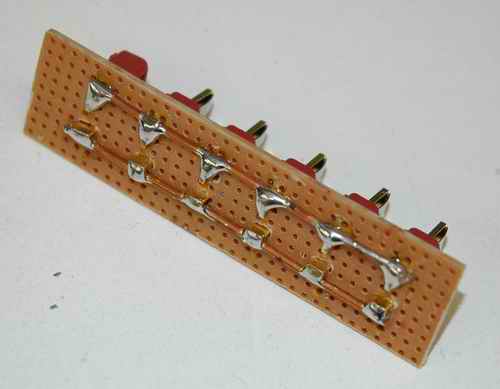
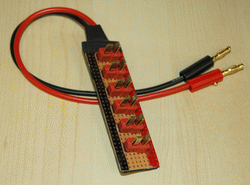 Deans Parallel LiPo Charging Board
Deans Parallel LiPo Charging BoardThe reason I built a board over a multi plug harness is so the male ends of the Deans plugs can’t short against each other (one thing I really don't like with Deans connectors).
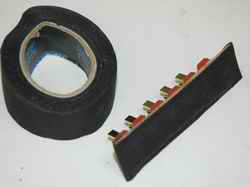
After you build your board, make sure you insulate the back side of it. I for example just used several layers of electrical tape.
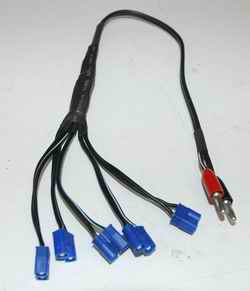 EC3 Parallel Charge Harness
EC3 Parallel Charge HarnessHere is the EC3 connector parallel charge cable I built and since EC3 connectors are insulated (better safer plug in my opinion), I didn’t bother using a board and just wired them all up in parallel.
One thing I should point out is the size of the wiring, especially the main wire from the banana plugs (red/black) to the connection point of the 5 EC3 plugs.
I could theoretically be pushing 20 Amps through this wire so it has to be a fairly good size gauge. I am using 14AWG and this seems very adequate. It only gets a little warm at a full 20 amp current load and the voltage drop over the very short length of wire is insignificant. 14AWG is also the size of the wiring used to power my charger, so that is a pretty good way to "gauge" it :-)
 JST Parallel Charge Harness
JST Parallel Charge HarnessHere's another example of a parallel charging harness I built that supports all my smaller LiPo packs that use JST connectors.
How To Build A Simple Parallel Balance Board
Next you will need to build yourself a parallel balancing board or harness.
I can't stress this point enough. If you are parallel charging multi celled LiPo packs, you must hook each cell up in parallel as well.
If you don't, yes, you will have cell voltage imbalance between packs and some cells could very well be getting overcharged!
I am first going to show the board I built and then a harness. Again, just as with the charge plugs, you generally need no more than 5 or 6 balance plugs to keep things in reason. As the name suggests, this board is also wired in parallel as you can see in the above photo.

The board I built here uses 6S JST-XH balance plugs since most of my LiPo packs use JST-XH balance taps and JST-XH plugs have a nice advantage... you can (with a little persuasion) fit different plug counts into the plugs.
For example, a 3 pin balancing plug will still plug into a 7 pin plug. This is nice so you don’t have to build several balancing boards with different plug pin counts.

Just like the parallel charge board, ensure you insulate the back side of the parallel balance board so it won’t short out on anything.
The parallel balance board you built will now plug into the Charger's balance port or board.
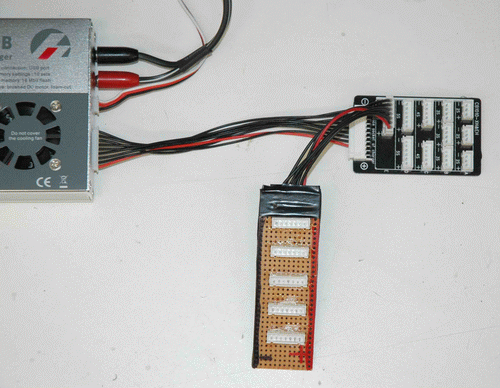 Parallel Balance Board Plugged Into Standard Balance Board
Parallel Balance Board Plugged Into Standard Balance BoardHere I have my parallel LiPo charging balance board plugged into the 6S plug on the balance board that came with the charger enabling me to parallel balance everything from a 2S pack to 6S pack. If I ever get into 7S, 8S or higher, I will have to build a new parallel balance board, but for now, I am very content with nothing larger than 6S packs.
How To Build A Simple Parallel Balance Harness
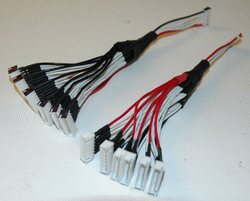
Here is another parallel LiPo charging balance method that will work and I find easier to both build and hook up. With a balance harness like this over a board, it is easier to hook up all your balance taps, especially if your batteries have short balance leads.
This is the same parallel balancing harness that I'm using in the video at the beginning of this section.
The first step is to get a number of female balance plugs with wiring on them if possible. Having the wiring in place saves considerable time.
Mounting them all lined up in the correct +/- orientation in a small vise as I have done here while working on each branch of wiring keeps things neat and mistake free.
Also note I have heat shrink already in place for insulating the solder connections when I put the male balance plug on.
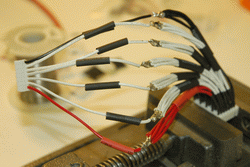
Once I have all the wiring sorted and soldered it is time to solder on the single male balance plug end that will plug into my charger's parallel charge port.
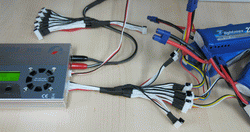
Now I have a 6S JST-XH parallel balance harness that plugs directly into my 208B charger's balance port making the hookup a little neater.
As you can see, a fair amount of work & understanding involved in making your own Parallel Charing Harnesses.
This is why I recommend just getting the many different available para-boards on the market these days for the plug type/s you use.
Calculating Your Charge Current When Para Charging
This is perhaps the question I get asked most often "what charge current do I use when parallel LiPo charging"? It's really simple math here. Basically when you have everything hooked up in parallel like this, your individual packs now have become one single big capacity pack.
I'll say that one more time in case you missed it. YOUR INDIVIDUAL PACKS HAVE NOW BECOME ONE BIG SINGLE PACK!
For instance, if you hooked three 2200 mAh 3S packs all up in parallel as I have done here, they essentially become one single big 6600 mAh 3S3P pack.
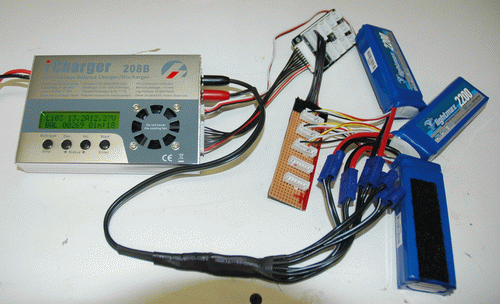
As per charge current calculations, a 1C charge rate on this pack is now 6600 mA (6.6 Amps). A 2C rate would be 13.2 Amps, and so on. I think you can now appreciate why high power chargers are generally required with this parallel LiPo battery charging method, as the wattage required in this example will be in the 83 Watt range at 1C and about 166 Watts at 2C.
Of course you don’t have to charge at a 1C or 2C rate, lower charge rates are always safest so a 0.5C rate of 3.3 Amps (41 Watts) will work just as well, it will just take twice to 4 times as long to charge.
The same calculations apply to packs of different capacities. Let's say we have one 4S 2500 mAh pack, one 4S 2800 mAh pack, and one 4S 3000 mAh pack all hooked together in parallel. That is the exact same thing as far as the charger is concerned as a single 4S 8300 mAh pack. A 1C charge rate set on your charger would therefore be 8.3 Amps.
Connection Warning Tip!
One very important caution when you hook all your packs up in parallel is, you MUST plug the main power plugs from the packs into the para-harness, or para-board first.
This way the potentially large current flowing between the packs as the voltages all equalize when they are first connected together flows through the heavy power wires and connectors and not the small wiring/connectors of the balance leads. Video demonstration of this shown already near the beginning of this article.
If you were to plug the balance plugs in first, that same potentially high short term voltage equalizing current flowing through the small balance wiring could overheat those small gauge wires, or the small balance plugs. It could even melt the circuit board trace lines on the Para-Boards.
If all the LiPo packs are at the exact same voltage potential when you hook them together in parallel, this is not a concern as there will be little to no current flow between all the packs because they are all at the same voltage potential. In the real everyday world however, that is unlikely so it's always best to plug the main power plugs in first and then the balance plugs.
Hopefully that gives you a little background and understanding on parallel LiPo charging and several methods of how to do it. As I said in the opening paragraph, the main reason I built this page was to show you why a higher power charger, even with smaller battery packs, may be a good long term investment.
You'll know you're a Parallel LiPo Charging junkie when...
